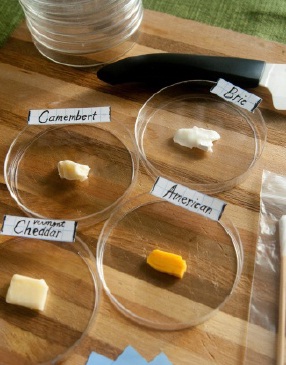





Published on Sep 12, 2023
Most of basic materials and equipment can be found in any kitchen. The cheeses can be purchased in the local super market or grocery store. The mold, rhiz opus, available in a Petri dish can be purchased from Ward`s Natural Science. Note: The Petri dish arrangement makes it easy to transport the fungus to the different cheeses.
Approximate Time Required to Complete the Project is 3 to 4 weeks. This includes the experimentation and the collection, recording and analysis of data, summary of results and completion of bibliography.
On the information level, this experiment serves to introduce students to the conditions under which molds grow, how they can be useful to us and how their growth can be controlled. In addition, the students learn how to conduct the experiment in a safe manner to prevent the effects of contamination. On the level of experimentation, this experience serves to acquaint students with the essential components of sciencing such as the importance of clearly defining the problem to be investigated, stating their hypothesis and their rationale for the hypothesis, the use of a control, of identifying dependent and independent variables, of data collection, of pictorial and or graphic presentation of data and of being able to make better judgments as to the validity and reliability of their findings. They take on the role of scientists and in the process they learn to act as one.
• What are molds?
• Where are molds found?
• Under what kinds of conditions do molds grow?
• How are molds useful to us?
• What is cheese and how is it made?
• What is the relationship between molds and the flavor of cheeses?
• What is penicillin?
• How are molds harmful to us?
• What are fungi?
• Are all fungi molds?
To determine which cheese grows mold fastest: Vermont Cheddar, American, Brie, or Camembert?

1. samples of Vermont Cheddar, American, American, Brie and Camembert
2. knife
3. cutting board
4. 8 Petri dishes
5. centimeter ruler
6. thermometer
7. Petri dish of the rhiz opus mold
8. sterile swabs
9. paper toweling or blotting paper
10. rubber gloves, apron or shirt as lab coatsanitiz er such as dilute liquid bleach.
1. State the problem you are going to investigate in this science fair project.
2. Create the data sheets you will use to record your observations.
3. Gather all your materials.
4 . Put on your safety glasses, apron and rubber gloves.
5. Clean the surface you will be working on with a dilute solution of bleach and water.
6. Set up the 8 Petri dishes into 4 sets of two labeling them with specimen numbers such as# 1 and #2 will contain Vermont Cheddar, #3 and #4 will contain Swiss ,# 5 and #6 will be Camembert etc.
7. Set up 4 Petri dishes, each of which will contain a sample of each cheese to serve as a control and label them.
8. Cut the paper toweling to fit the Petri dishes, line the Petri dishes with the paper and soak each of the papers with a medicine dropper of water.
9. Slice all the cheeses into equal segments and place them in the labeled Petri dishes and in the controls.
10. Using sterile swabs open the Petri dish of rhiz opus and transfer an equal amount of the mold to each of the cheeses. Do not inoculate the controls!
11. Store the dishes in a warm place (75-80 degrees F) and in a dark place, a drawer or in a closed box.
12. Observe, measure and record the growth of the mold using your centimeter ruler on a daily basis for two weeks.
13. You may wish to make sketches of your observations and /or take photos of the mold growth to substantiate your observations.
14 . Graph your data. A graph presents an instant picture of the findings.
15. Prepare your report and include all of the following: a clear statement of the problem, your hypothesis, the rationale for your hypothesis, and a list the materials used. Include the safety precautions taken. Describe the procedures used. Include all the data that were gathered. Include all charts and graphs.
Formulate your conclusions. For dramatic value, you may include photos of the materials used or of you in the process of conducting this investigation. Include a bibliography of sources you used. You may wish to assess what you did and describe what you would do differently if you were to do this project again. In addition, you may include what you view as the practical applications of your project as well as what further research you may wish to conduct on this subject.
1. Ammirati, Joe F. “Mold,” World Book Encyclopedia, 2002.
2. Edelman, E. and Grodnick, S. The Ideal Cheese Book, 1986.
3. "Facts About Mold." December 8, 2004 .
4 . www.answers.com/topic/cheese